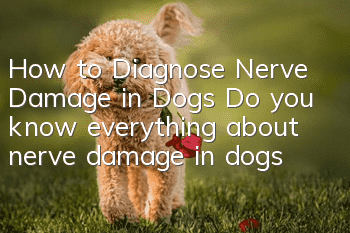How to Diagnose Nerve Damage in Dogs Do you know everything about nerve damage in dogs?

Methods to judge nerve damage in dogs
1. Brain damage:
Generally, dogs will be excited or depressed, often turning to the injured side, with abnormal posture and movement, but will not walk Normal condition; reduced vision or blindness, normal pupillary reflex, olfactory impairment, and weakened postural response of the contralateral limb.2. Midbrain damage:
Dogs with nerve damage will suffer from depression or coma, dilated pupils, strabismus, no response to light, but normal vision and drooping of the upper eyelids.3. Cerebellar damage:
Once a dog has damage to its cerebellum, it will suffer from muscle tone loss.4. Injury to the hypothalamus:
Dogs will show abnormal behavior, such as excitement, aggression, disorientation, coma, etc.; their vision is weakened, their pupils are dilated, and their light reflexes are weakened. Disorders of thermoregulation. Endocrine and water and salt metabolism disorders, hyperappetite.5. Damage to the vestibular system:
The dog's balance will be imbalanced, with head tilt and droop, nystagmus, medial strabismus, and dysfunction of the trigeminal nerve, abducens nerve, and facial nerve.6. Pontine damage:
Dogs have contralateral hemiplegia, reduced or absent pain sensation, ataxia, and trigeminal and facial nerve dysfunction.7. Brain injury:
Ipsilateral or contralateral hemiplegia, increased muscle tension and reflexes, nystagmus, glossopharyngeal paralysis, and irregular breathing.8. Cervical spine injury:
Neck pain and neck stiffness. The extension and flexion capabilities of the head and neck are reduced, and muscle tension and reflexes are enhanced. Some sick dogs may have difficulty breathing and cervical sensorineural syndrome.9. Thoracic and lumbar spine injuries:
Hind limb paralysis, increased muscle tension, no muscle atrophy; urinary incontinence. The damaged local sensitivity is enhanced and the hindlimb position response is weakened.10. Damage to the lumbar and sacral vertebrae:
Flaccid weakness or paralysis of the hind limbs and tail. Muscle atrophy, urinary incontinence, slow defecation reaction, and weakened hind limb positioning reaction. Severe damage may result in paralysis of the hindquarters. Random articles
- What do dogs eat to protect their stomach? It is important to protect their stomach and treat gastrointestinal diseases in dogs.
- How to tell if your dog is fat? Is your dog overweight?
- Will your dog catch a cold if you blow the air conditioner? What should you do if your dog catches a cold if you blow the air conditioner?
- What should you pay attention to when your dog drinks water? Don’t be careless when it comes to your dog’s drinking water.
- The dog's mouth bites and shakes. Why does the dog's mouth occasionally shake and bite?
- How to cut a dog's hair? Do you know how to cut a dog's hair correctly?
- Can dogs eat raw eggs? Why can’t dogs eat egg whites?
- Common Dog Problems in Summer How to Deal with Different Dog Problems
- How to keep dogs away from skin diseases. If you do this, will you see if your dog will still be infected with skin diseases?
- What causes anorexia in dogs? Dogs will become anorexic due to lack of exercise. Hounds run at least 5KM every day.



